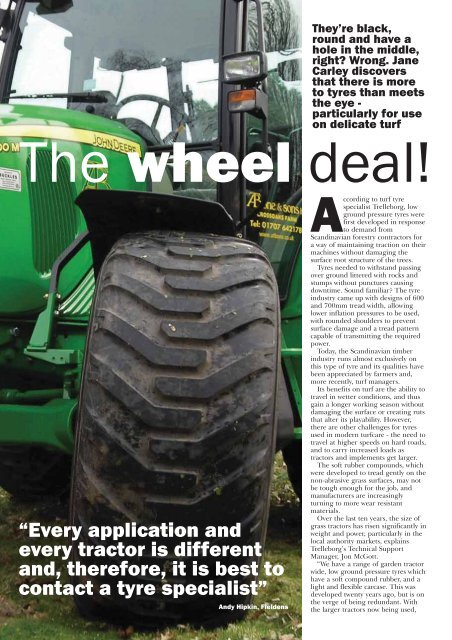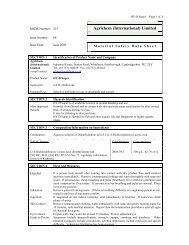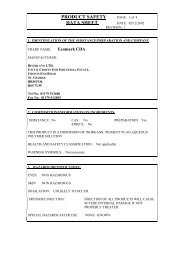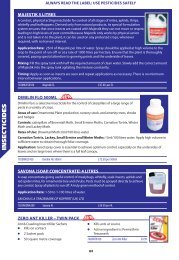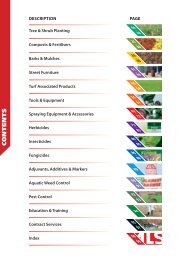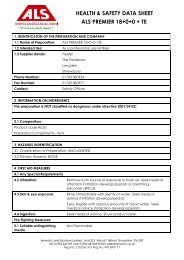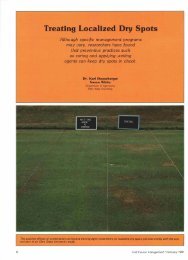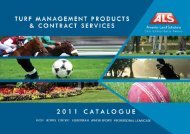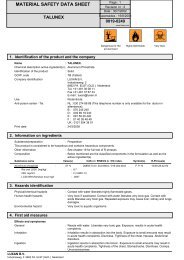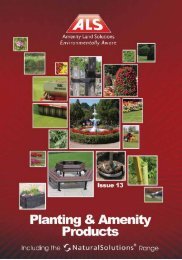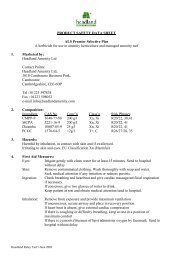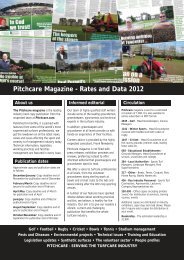Marshalling his troops - Pitchcare
Marshalling his troops - Pitchcare
Marshalling his troops - Pitchcare
You also want an ePaper? Increase the reach of your titles
YUMPU automatically turns print PDFs into web optimized ePapers that Google loves.
They’re black,<br />
round and have a<br />
hole in the middle,<br />
right? Wrong. Jane<br />
Carley discovers<br />
that there is more<br />
to tyres than meets<br />
the eye -<br />
particularly for use<br />
on delicate turf<br />
The wheel deal!<br />
“Every application and<br />
every tractor is different<br />
and, therefore, it is best to<br />
contact a tyre specialist”<br />
Andy Hipkin, Fieldens<br />
According to turf tyre<br />
specialist Trelleborg, low<br />
ground pressure tyres were<br />
first developed in response<br />
to demand from<br />
Scandinavian forestry contractors for<br />
a way of maintaining traction on their<br />
machines without damaging the<br />
surface root structure of the trees.<br />
Tyres needed to withstand passing<br />
over ground littered with rocks and<br />
stumps without punctures causing<br />
downtime. Sound familiar? The tyre<br />
industry came up with designs of 600<br />
and 700mm tread width, allowing<br />
lower inflation pressures to be used,<br />
with rounded shoulders to prevent<br />
surface damage and a tread pattern<br />
capable of transmitting the required<br />
power.<br />
Today, the Scandinavian timber<br />
industry runs almost exclusively on<br />
t<strong>his</strong> type of tyre and its qualities have<br />
been appreciated by farmers and,<br />
more recently, turf managers.<br />
Its benefits on turf are the ability to<br />
travel in wetter conditions, and thus<br />
gain a longer working season without<br />
damaging the surface or creating ruts<br />
that alter its playability. However,<br />
there are other challenges for tyres<br />
used in modern turfcare - the need to<br />
travel at higher speeds on hard roads,<br />
and to carry increased loads as<br />
tractors and implements get larger.<br />
The soft rubber compounds, which<br />
were developed to tread gently on the<br />
non-abrasive grass surfaces, may not<br />
be tough enough for the job, and<br />
manufacturers are increasingly<br />
turning to more wear resistant<br />
materials.<br />
Over the last ten years, the size of<br />
grass tractors has risen significantly in<br />
weight and power, particularly in the<br />
local authority markets, explains<br />
Trelleborg’s Technical Support<br />
Manager, Jon McGott.<br />
“We have a range of garden tractor<br />
wide, low ground pressure tyres which<br />
have a soft compound rubber, and a<br />
light and flexible carcase. T<strong>his</strong> was<br />
developed twenty years ago, but is on<br />
the verge of being redundant. With<br />
the larger tractors now being used,


